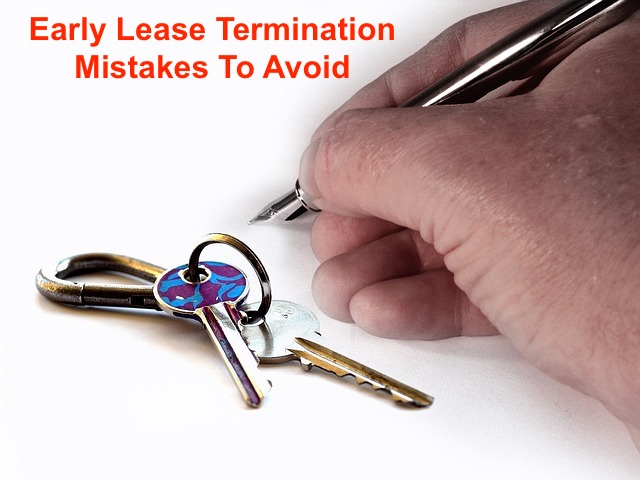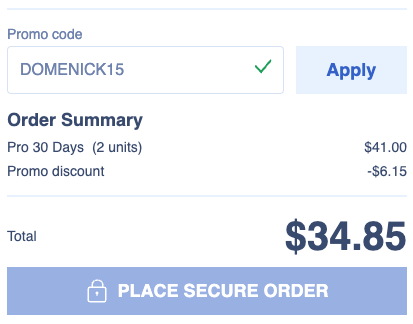I was recently asked by a tenant to include an early lease termination clause in the lease renewal. I normally avoid these clauses because I try to time my renewals for peak season and peak rent rates. See landlord tip #33.
However, sometimes tenants simply need to move before the lease is up. It’s our job as landlords to find a solution that fits everyone’s needs. These situations can be tricky. If you are not careful, you can incur extra costs in the form of a vacancy or worse, you might violate your tenant’s rights and end up in court.
Every situation is unique. You need to treat each request individually but it’s a good idea to have a general policy in place ahead of time.
In my case, I have a great tenant who wants to stay in the rental indefinitely (awesome!) but due to family reasons, might need to move. We worked together to craft a unique win-win early lease termination clause. It gave him the flexibility he needed in case he needs to move in the next year but also gave me significant coverage too.
In this article I will:
- Explore your 4 options when faced with an early lease termination
- Tell you the 3 common mistakes to avoid with early lease terminations
- Detail what to include in your early lease termination clauses
- Walk you through the process of creating an early lease termination addendum with ezLandlordForms
What Are My Options For Handling Early Lease Terminations?
As a landlord, you have several options when it comes to handling early lease terminations. Below are four options that give you and your tenant a range of flexibility.
Option 1 – Hold Them To The Lease (Completely Inflexible)
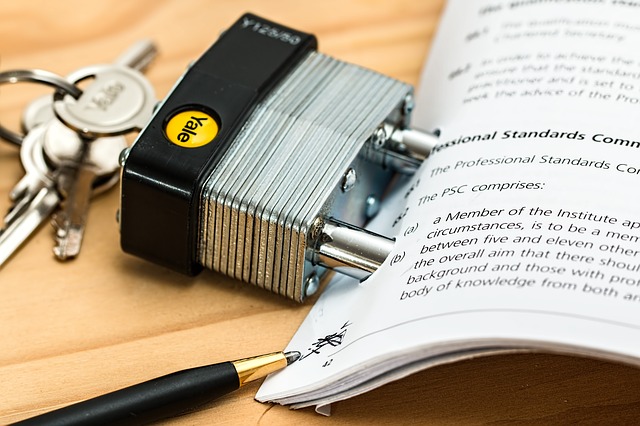
A lease is a contract and you can generally hold your tenant to its strict terms. When a tenant asks to get out of a lease you can tell them that you expect them to fulfill their obligations under the lease. If they leave, you can then sue them for the amount still owed.
This is the least flexible option and comes with challenges. The reality is that tenants often need to leave for valid reasons. Your tenant may have the right to walk away regardless of the lease in some cases. If faced with an unexpected vacancy due to an early lease termination, here are some important facts to consider:
Duty To Mitigate Damages
Many states require a landlord to mitigate their losses by finding a new tenant ASAP. So you can’t hold them to the full term of the lease regardless.
This means you need to actively market the rental at a fair market rate. You can’t post the rental at double the market rate and then wait for the current lease to run out.
Protected Classes
Federal, State and Local laws often protect certain classes and allow them to terminate a lease early with little or no penalty.
Military Service Members
The Servicemembers Civil Relief Act (SCRA) allows military personnel assigned to another location to break their lease with as little as 30 days notice.
Domestic Abuse Victims
According to the National Housing Law Project, 27 states have enacted early termination protections for domestic abuse survivors. There are also protections against eviction (you can’t evict the tenants because they are causing trouble).
Most states also allow a judge to split the lease to exclude the abuser from the property regardless of who was on the lease.
See your state’s domestic abuse housing protections in this comprehensive guide from the NHLP.
Bad Reputation
Not working with your tenant will give you a bad reputation. Word can quickly spread that you are not an easy landlord to deal with. This can hurt your ability find new tenants and ultimately cost you in vacancies.
Other Legal Ways To Break A Lease
If you refuse to let your tenant out of a lease early they may look for other legal reasons to break the lease. If you haven’t lived up to the strict terms of the lease as a landlord, your tenant could build a case to break the lease early.
Have you made all necessary repairs? Could they argue the place is inhabitable? Have you fulfilled every lease obligation to the letter?
It may be easier to find a new tenant than it is to constantly try to please a tenant for fear they may have cause to break the lease.
Judges Expect You To Be Reasonable
Not working with your tenant won’t look good for you if you ever get in front of a judge. They generally frown upon landlords who refuse to let a tenant out of a lease, especially in tenant-friendly states. You don’t want to get a reputation of being a bad landlord with the local judges.
Option 2 – Agree To An Early Lease Termination (Somewhat Inflexible)

The second option is to wait for a tenant to approach you about an early lease option. Then you can negotiate to work out an agreement with the tenant to let them end the lease early.
In this scenario, you both agree to an early lease termination even though the lease doesn’t technically allow for one. The tenant will be responsible for the rent until the unit is rented again but there is no early lease termination fee.
The agreement should be very specific as to each party’s obligations. You need to spell out exactly what your tenant needs to do in order to have the lease terminated. For example, you could agree that the tenant needs to keep the place in ready-to-show shape and allow you to have one or more open houses.
The advantage of this option is that it keeps your tenant vested in helping you rent the unit as quickly as possible because they are still on the hook for the rent. In exchange for no early lease termination fee, they agree to pay you rent until the apartment is rented again. They know the faster it’s rented the faster they get out of the lease. They will often put the word out in their network about the available apartment.
It also has the advantage of minimizing disputes. There isn’t much to dispute without an early lease termination fee. You won’t risk a judge determining your fee was excessive either.
Option 3 – Build In An Early Lease Termination Clause (Somewhat Flexible)

Another approach is to plan for the inevitable by including an early lease termination clause in your leases. You can build in an option for your tenants to end the lease early in the contract. This gives them the flexibility they want but at a price that offsets your extra costs.
However, early termination costs are unpredictable. It’s hard to estimate how much an early lease termination will cost you because it is very dependent on the market, the time of year, turnover costs, etc.
Many landlords simply require 30 days notice and charge a fee of one or two month’s rent. Others offer a sliding scale depending on the duration left on the lease. Some will go so far as to exclude early lease terminations during the off-season (typically December – February).
Whatever you decide to use, be sure it’s a reasonable approximation of the costs you are likely to incur due to the early lease termination. You also want to make sure it’s in line with the local market and worded appropriately.
Option 4 – Month-to-Month Leases (Completely Flexible)

Sometimes tenants and landlords want the most flexibility. In these cases, a month-to-month lease is best. In this option the landlord and the tenant each assume the risk of an “early” lease termination.
The tenant is free to leave after giving proper 30 days notice. However, the landlord is free to terminate the lease with the same notice.
While this offers the tenant the most flexibility, it can leave the landlord with extra expenses in the offseason or if the demand slows in the local market. To offset this risk, many landlords charge a premium for month-to-month leases. This premium can range between a few extra dollars per month to several hundred depending on the landlord’s and tenant’s situation.
3 Mistakes To Avoid With Early Lease Terminations
Every landlord will eventually be faced with a tenant who wants or needs to break the lease. This happened with my very first tenant actually! I chose option 2 above. I worked with my tenant to create a new agreement to end the lease early. It worked out OK but in retrospect I could have done some things better.
Here are some common mistakes newbie landlords make when faced with an early lease termination situation. Avoid these potentially costly mistakes.
1 – Not Working With Your Tenant

You and your tenant have a contract and you should each be held accountable generally speaking. However, life happens and sometimes a tenant needs to move. It’s better to work with them than to risk feelings of resentment, which can lead to retaliation. Disgruntled tenants can do far more costly damage than just letting them loose from the contract.
Some tenants may have a legal right to end the lease early. You could be violating their rights if you refuse to let them out of the lease.
Here are some common situations when a landlord could be obligated to end a tenancy early.
- Military families who receive a permanent change of station order
- Domestic abuse victims
- Families suffering a death or serious injury
Check your local laws and consult an attorney if in doubt.
Duty to mitigate damages
Most states require the landlord to make reasonable efforts to mitigate their damages when a tenant breaks a lease early. This generally means doing your normal process to get the unit rented again. It doesn’t mean you need to go above and beyond. You don’t need to rent it to the first applicant regardless of qualifications. Nor do you need to drop everything you are doing to get the unit re-rented.
Nolo has an excellent chart that tells you exactly what your state says on the duty to mitigate damages during an early lease termination situation.
2 – Not Including A Provision Allowing You To Show The Rental

Time is of the essence in an early lease termination situation so you need to move quickly. Your lease should already include a provision to allow showings when a tenant ends their lease under normal circumstances. See landlord tip #17. An early lease termination agreement should include this as well.
You need to limit your losses and that means renting it out fast. This is especially true in the offseason. Be reasonable and work with your tenant on normal showing hours.
Consider adding these points:
- Ask for at least one open house but two is better
- Open houses should be two hours or more
- Tenants shouldn’t be present during showings
- Offer to give 24 hours notice unless mutually agreed to a shorter notice
- Tenants must keep the place tidy and accessible
Whether you have a lease buyout clause or work with your tenants on a case by case basis, it always makes sense to include a provision like this.
3 – Excessive Early Lease Termination Fees

Early lease termination fees can be tricky. On the one hand it is generally understood under the law that it’s hard to predict a landlord’s loss due to an early lease termination. But on the other hand, these fees need to be a reasonable estimate of the landlord’s actual costs incurred.
In other words, they are meant to be a reasonable estimate of something that is difficult to estimate.
How to estimate reasonable lease termination costs?
Here are some costs you may be able to consider when trying to estimate your costs when a tenant breaks their lease early.
- Average vacancy rate
- Marketing expenses
- Expenses incurred to make the unit ready to rent again
- Costs of showing the property (e.g., miles driven)
- Tenant screening costs
These can easily add up to thousands of dollars. Many early lease termination fees are equal to one or 2 months of rent for this reason.
PRO TIP: Avoid equating the early lease termination fee to a rent charge by saying it is “two month’s rent” for example. Instead, state the specific dollar amount or better yet, vary it a little.
PRO TIP: Never agree to let the tenant forfeit the security deposit as an early lease termination fee. If a tenant leaves behind damages you will have to fight them to get the damages covered too. Good luck.
Even if you and your tenant agree to an early lease termination fee, a judge can declare it excessive if the tenant later disputes it in court.
These fees can also sometimes lead to resentment. If your lease includes a buyout clause, your tenant may object to the two-month fee when it comes time to pay up. It may be best to work with them anyway.
What To Include In An Early Lease Termination Agreement
Now you know the common mistakes new landlords make when a tenant wants to break their lease agreement. It’s time to review how to write an early lease termination agreement that has a better chance of holding up in court.
If your tenant needs to break the lease but there is no early lease termination clause in your lease, then you need to create a lease addendum. An early lease termination addendum will spell out each party’s rights and responsibilities.
Here are the key points you need to include in your early lease termination addendum.
The Basics
- Reference the current lease including the effective date
- Identify the parties to the addendum (and lease)
- Identify the property address
Why Are You Adding A Lease Addendum?
- Include a statement that the tenant understands the landlord incurs extra costs when the tenant terminates the lease before the end date
- These costs are by nature unknowable and difficult to estimate
- The tenant agrees to paying a fixed, estimated amount in lieu of actual costs
The Details
- Include how much the tenant must pay to end the lease early
- Tell the tenant when and how they need to submit notice of their intention to terminate the lease early
- Explicitly state when the early lease termination will be in effect and when the lease will end
Special Wording To Include
- Tenant understands and agrees that this charge is a reasonable estimate of the landlord’s likely costs
- The tenant agrees to pay the charge regardless of when the landlord actually re-rents the apartment
- The charge is an early move out charge and not “extra rent” or a fine that relieves them of any other duties under the original lease agreement
- The early lease termination addendum is void if the tenant fails to live up to their obligations in the addendum
- Tenant has read and understands the addendum
Other Considerations
- You may wish to require that the tenant be in good standing in order to use the early lease termination option
- As noted above, you should always include a provision for allowing showings
Using ezLandlordForms To Write An Early Termination Addendum

If you want a solid early lease termination agreement but aren’t comfortable writing one yourself, you can use an online landlord forms service such as ezLandlordForms.
Click on the link above and follow these steps:
Choose “State-Specific Forms” from the FORMS drop down menu
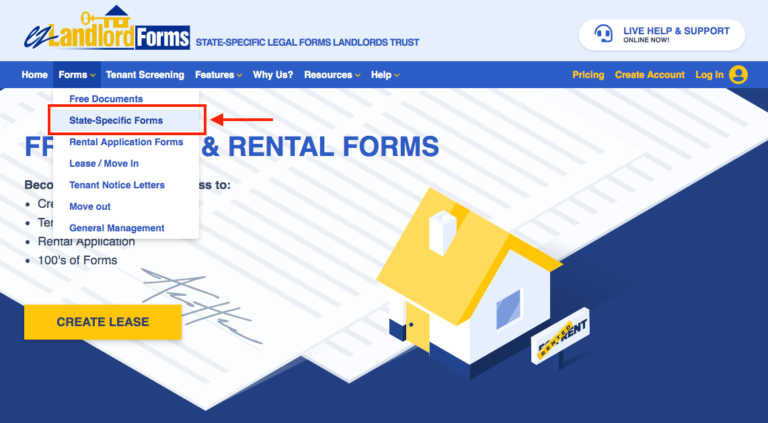
Search for “Early Lease Termination” in the search bar
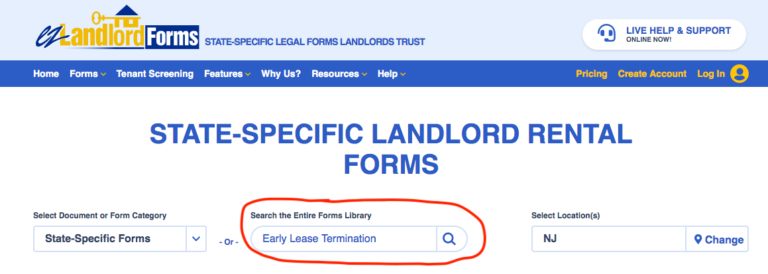
Choose the “Early Lease Termination Addendum”
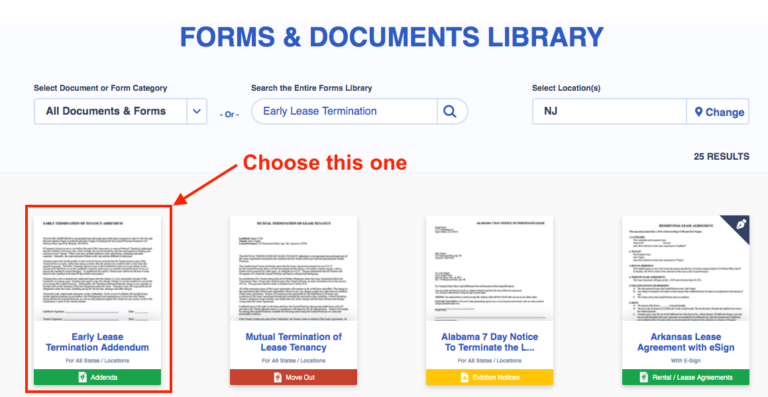
Click “Create Document” from the preview screen
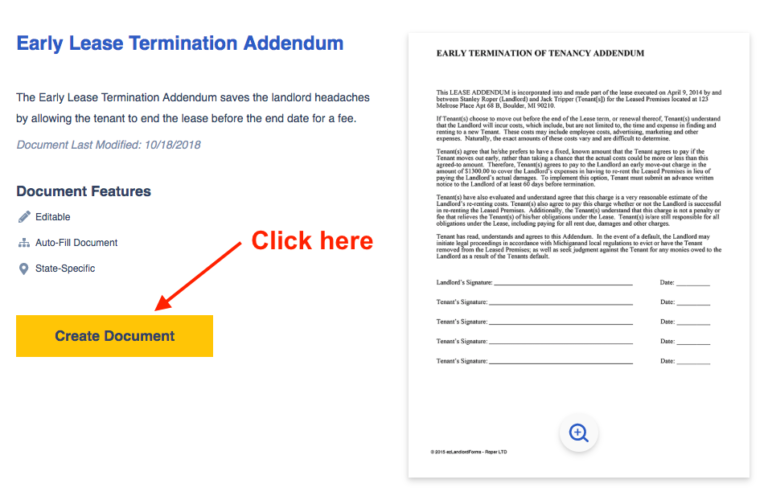
Follow the steps to sign up as a pro member to be able to edit the document
Save on ezLandlordForms!
AccidentalRental readers can use promo code “DOMENICK15” to save 15%. That’s $52 off a lifetime membership!
Ask A Lawyer Online Now
Need a quick answer from a legal expert but don’t want to retain an attorney?
Try Rocket Lawyer’s Ask-A-Lawyer service (affiliate partner). Their on-call network of lawyers can answer your question fast without the high fees.
Conclusion
Every landlord will eventually need to deal with a tenant who wants to break their lease early. Know your policy on early lease terminations in advance so you can act swiftly when the time comes.
Decide how flexible you will be when it comes to early lease terminations. Will you hold the tenant to the lease terms or will you let them go month to month? However you decide to handle the early lease termination be sure you follow your local laws and customs. Don’t charge excessive termination fees and avoid any fee that can be perceived as double dipping rent.
Also be sure to include all the necessary information in your formal early lease termination addendum. Add smart clauses that will help you get the unit rented faster. Use an online landlord form service like ezLandlordForms if you aren’t comfortable writing the agreement yourself.
Want More Landlord Tips?
Sign up today for the Accidental Rental monthly newsletter for access to more free money saving tips and tricks to being an awesome landlord!

